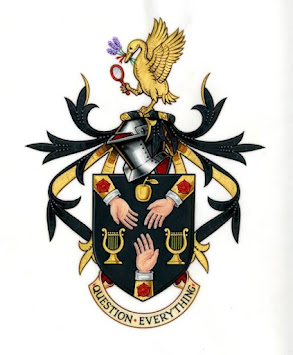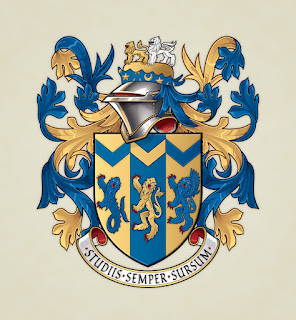The Journey of the Bee
The Journey of the Bee
By Jean-Eudes Pierra
When I was asked why I created an association dedicated to the heraldry of bees, I must admit, I hesitated. After all, while many people devote their time to humanitarian or environmental causes, why invest energy in coats of arms and heraldry? The answer, in fact, is simpler than it might seem: it’s primarily a matter of passion. A passion for that ancient art of heraldry and a fascination with the bee, a symbol as universal as it is mysterious.
The arms of Jean-Eudes Pierra. Gules, three bees Or, and in chief Azure, an eagle displayed. Represent his passion for Napoleonic history. The bees are inspired by those scattered on the purple coronation mantle of Napoleon, while the eagle was attributed to sovereign Princes under imperial rule. The eagle also echoes the evangelist Saint John.
The idea to create an armorial dedicated to bees was born out of a conversation with Giuseppe Meliti, a friend I met on a heraldry forum. Both of us had bees on our respective coats of arms. Intrigued, we wondered how many other families, institutions, or notable figures throughout the ages had chosen this same symbol. What began as a mere curiosity quickly evolved into a project: identifying and gathering all the coats of arms featuring bees, and, more importantly, uncovering the stories they tell.
For this is the real charm of heraldry: these symbols frozen in time are far from simple decorations. They carry histories, values, beliefs, and sometimes even secrets. And the bee, in this context, says a great deal about those who chose it.
The question often arises: why the bee? What does this small insect signify for those who emblazoned it on their arms? The answer is not singular, and perhaps that is what makes this symbol so fascinating. Throughout the centuries, the bee has taken on various meanings.
In ancient Egypt, it was associated with royalty. For the Merovingian kings, it represented the resurrection of Christ and royal dignity, a symbol later adopted by Napoleon to replace the fleur-de-lis on his coronation robe. Today, the bee is often seen as a symbol of hard work, cooperation, and order in society. It embodies a well-organized community where each individual has a specific role to play.
The arms of Giuseppe Meliti, Co-Founder.
Or, on a bend azure three bees or, for crest upon a helm with a wreath of the liveries, a rampant lion with a halberd. The arms recalls the surname: Meliti in ancient Greek; the bees and honey, and Mel in Latin means honey. In addition to being, therefore, a typical canting arm, the symbol also represents the value of industriousness and work for the common good. The three bees represents the Holy Trinity and the perfection. The blue band recalls the rivers of the cities of his life (“Lambro” for Monza and “Naviglio della Martesana” for Cernusco sul Naviglio) and the sea of the region from which the family comes (sea of Calabria).
Gold represents royalty, nobility of mind, Faith and justice, fundamental principles for my life. The crest represents strength and royalty and the halberd belonging to the Corps of the Alabardiers of the Cathedral of Monza (Alabardieri del Duomo di Monza). The motto recalls a verse from the Gospel according to Matthew, which is fundamental to his life.
But there is also a more contemporary dimension to this fascination with the bee. In times when bees are threatened by environmental changes, they symbolize the fragility of our modern world, a world where everything is interconnected, and balance can easily be lost.
In exploring coats of arms with bees, we embarked on an unexpected journey through history and across continents. From Europe to North America, from Russia to Brazil, bees fly from one coat of arms to another, but their significance shifts with the times. Every encounter with a bearer of bee heraldry opens a new door: whether it be a 17th-century Pope, a 20th-century professor, a Prime Minister, or an Austrian industrialist. Each, in some way or another, found in the bee a symbol that represented them.
Ultimately, this quest around bee heraldry reminds us of one thing: we live in a world where symbols are gradually losing their meaning. Once, every coat of arms, every symbol, told a story. Today, through our work on the bee armorial, we are trying to revive this tradition, to rediscover that human need to find meaning in the things around us.
Heraldry, in its own way, is an attempt to inscribe ourselves in the grand narrative of history. And like the bee, it invites us to reflect on the fragility and beauty of these stories, on their ability to endure through time while remaining deeply rooted in the realities of each era.











Bees feature in the crest of the arms of the Manchester City Corporation; the most recent armiger to pursue an action through the Court of Chivalry in England. https://manchesterbe.es/index.php/2018/05/16/manchester-coat-of-arms-bees-manchester-city-council/
ReplyDeleteCheers, Paul!
DeleteBrilliant! 🐝
ReplyDeleteBrilliant! 🐝
ReplyDeleteBrilliant!
ReplyDeleteThank you all for your comments. Keep them coming!
ReplyDeleteAs an avid gardner and heraldry enthusiast, I think this is such a wonderful and intriguing project. I would love to see this armorial when it is completed!
ReplyDeleteHappy to 🐝 part of this armorial (so to speak)! I was actually surprised to see how many modern arms have bees
ReplyDeleteAmazing!
ReplyDelete